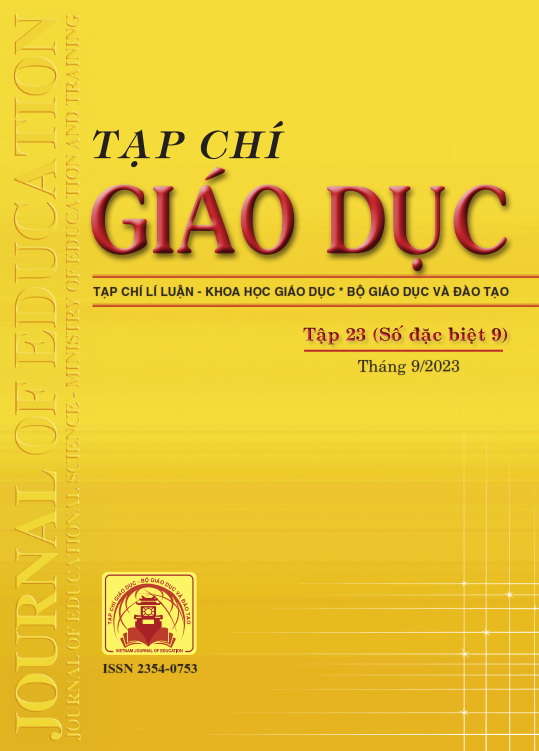Khảo sát nhận thức của giảng viên và sinh viên về ảnh hưởng của ChatGPT lên hoạt động dịch thuật của sinh viên chuyên ngành Biên - Phiên dịch Trường Đại học Nguyễn Tất Thành
Tóm tắt
While machine translation models are inherently predictive, with precision expected, generative models like ChatGPT can open new avenues for translators and the translation industry. This mixed-methods study examines the impact of ChatGPT on translation practices at Nguyen Tat Thanh University by exploring the perceptions and attitudes of 208 translation undergraduates and 20 EFL teachers at NTTU. The study aims to answer two research questions: (1) To what extent are translation students aware of the effect of ChatGPT on their own translation practices? (2) What are the perceptions and attitudes of EFL teachers towards the impact of ChatGPT on students’ translation practices? Data were collected through online surveys and interviews. The findings of the study indicate that ChatGPT has emerged as a language learning tool assisting in the translation process. However, the perceptions and attitudes of EFL educators towards the impact of ChatGPT on translation practices were contradictory in terms of its potential misuse in translation studies. The students, on the other hand, appeared to be quite interested in exploring the practical applications of ChatGPT as a machine translation tool. It is hoped that this study provides valuable insights into the implications of computer-assisted translation tools for future language learning and teaching.
Tài liệu tham khảo
Alhaj, A. A. M., & Albahiri, M. H. (2022). Exploring the Impact of Utilizing Weblogs Platform Technology to Enhance Translation Female Students' Written Translation Performance at King Khalid University. Arab World English Journal, 13(4), 53-66. https://dx.doi.org/10.24093/awej/vol13no4.4
Briggs, N. (2018). Neural machine translation tools in the language learning classroom: Students' use, perceptions, and analyses. The JALT CALL Journal, 14(1), 3-24. https://doi.org/10.29140/jaltcallv14n1.221
Cotton, D. R., Cotton, P. A., & Shipway, J. R. (2023). Chatting and cheating: Ensuring academic integrity in the era of ChatGPT. Innovations in Education and Teaching International, 1-12. https://doi.org/10.1080/14703297.
2190148
Choi, S., Jang, Y., & Kim, H. (2023). Influence of pedagogical beliefs and perceived trust on teachers’ acceptance of educational artificial intelligence tools. International Journal of Human-Computer Interaction, 39(4), 910-922.
Dijkstra, R., Genç, Z., Kayal, S., & Kamps, J. (2022). Reading comprehension quiz generation using generative pre-trained transformers. https://e.humanities.uva.nl/publications/2022/dijk_read22.pdf
Fountain, A., & Fountain, C. (2009) A New Look at Translation: Teaching tools for language and literature. Empowerment through Collaboration: Dimension, 1-15. http://scholarworks.sjsu.edu/world_lang_pub/1/
Hendy, A., Mohamed, A., Sharaf, A. (2023). How good are GPT models at machine translation? A comprehensive evaluation. Computation and Language. Computation and Language. 10.48550/arXiv.2302.09210
Jiao, W., Wang, W., Huang, J., Wang, X., & Tu, Z. (2023). Is ChatGPT a good translator? Yes with GPT-4 as the engine. Computation and Language. https://doi.org/10.48550/arXiv.2301.08745
Kong, X. (2022). Towards Efficient Neural Machine Translation (Version 1). Carnegie Mellon University. https://doi.org/10.1184/R1/21707942.v1
Niño, A. (2009). Machine translation in foreign language learning: language learners’ and tutors’ perceptions of its advantages and disadvantages. Recall, 21(2), 241-258. https://doi.org/10.1017/S095834400900017
NLLB team, Costa-jussa, Marta, R., Cross, J. & Çelebi, O., Elbayad, M. & Heafield, K., Heffernan, K., Kalbassi, E., Lam, J., Licht, D., Maillard, J., Sun, A., Wang, S., Wenzek, G. & Youngblood, A. & Akula, B. & Barrault, L., Gonzalez, G. & Hansanti, Pr., & Wang, J. (2022). No Language Left Behind: Scaling Human-Centered Machine Translation. Computation and Language. https://doi.org/10.48550/arXiv.2207.04672
Ouyang, L., Wu, J., Jiang, X., Almeida, D., Wainwright, C. L., Mishkin, P., Zhang, C., Agarwal, S., Slama, K., Ray, A., Schulman, J., Hilton, J., Kelton, F., Miller, L., Simens, M., Askell, A., Welinder, P., Christiano, P., Leike, J., & Lowe, R. (2022). Training language models to follow instructions with human feedback. Computation and Language. https://doi.org/10.48550/arXiv.2203.02155
Peng, K., Ding, L., ZhongR, Q., Shen L., Liu, X., Zhang M., Ouyang, Y., & Tao D. (2023). Towards Making the Most of ChatGPT for Machine Translation. Computation and Language. https://doi.org/10.48550/arXiv.2302.09210
Polak, S., Schiavo, G., & Zancanaro, M. (2022). Teachers’ Perspective on Artificial Intelligence Education: An Initial Investigation. Proceedings of CHI Conference on Human Factors in Computing Systems, 431, 1-7. https://doi.org/10.1145/3491101.3519866
Qadir, J. (2022). Engineering education in the era of ChatGPT: Promise and pitfalls of generative AI for education. In 2023 IEEE Global Engineering Education Conference (EDUCON) (pp. 1-9). IEEE.
Qin, C., Zhang, A., Zhang, Z., Chen, J., Yasunaga, M., & Yang. C. (2023). Is ChatGPT a general-purpose natural language process- ing task solver?. Computation and Language. https://doi.org/10.48550/arXiv.2302.06476
Steding, S. (2009). Machine translation in the German classroom: Detection, reaction, prevention. Teaching German, 42(2), 178-189. https://doi.org/10.1111/j.1756-1221.2009.00052.x
Tamkin, A., Brundage, M., Clark, J., & Ganguli, D. (2021). Understanding the capabilities, limitations, and societal impact of large language models. Computation and Language. https://doi.org/10.48550/arXiv.2102.02503
Wang, A., Yuanzhe, R., Chen, A., Phang, J., & Bowman, R. (2022). Squality: Building a long-document summarization dataset the hard way. Computation and Language. https://doi.org/10.48550/arXiv.2207.04672
Ying, W., Shang H. & Briody, P. (2013). Exploring the impact of using automated writing evaluation in English as a foreign language university students' writing. Computer Assisted Language Learning, 26(3), 234-257. https://doi.org/10.1080/09588221.2012.655300
Zhang, W., Dai, L., Liu, J., & Wang, S. (2023). Improving many-to-many neural machine translation via selective and aligned online data augmentation. Applied Sciences, 13(6), 39-46. https://doi.org/10.3390/app13063946
Đã Xuất bản
Cách trích dẫn
Số
Chuyên mục
Giấy phép

Tác phẩm này được cấp phép theo Ghi nhận tác giả của Creative Commons Giấy phép quốc tế 4.0 .












